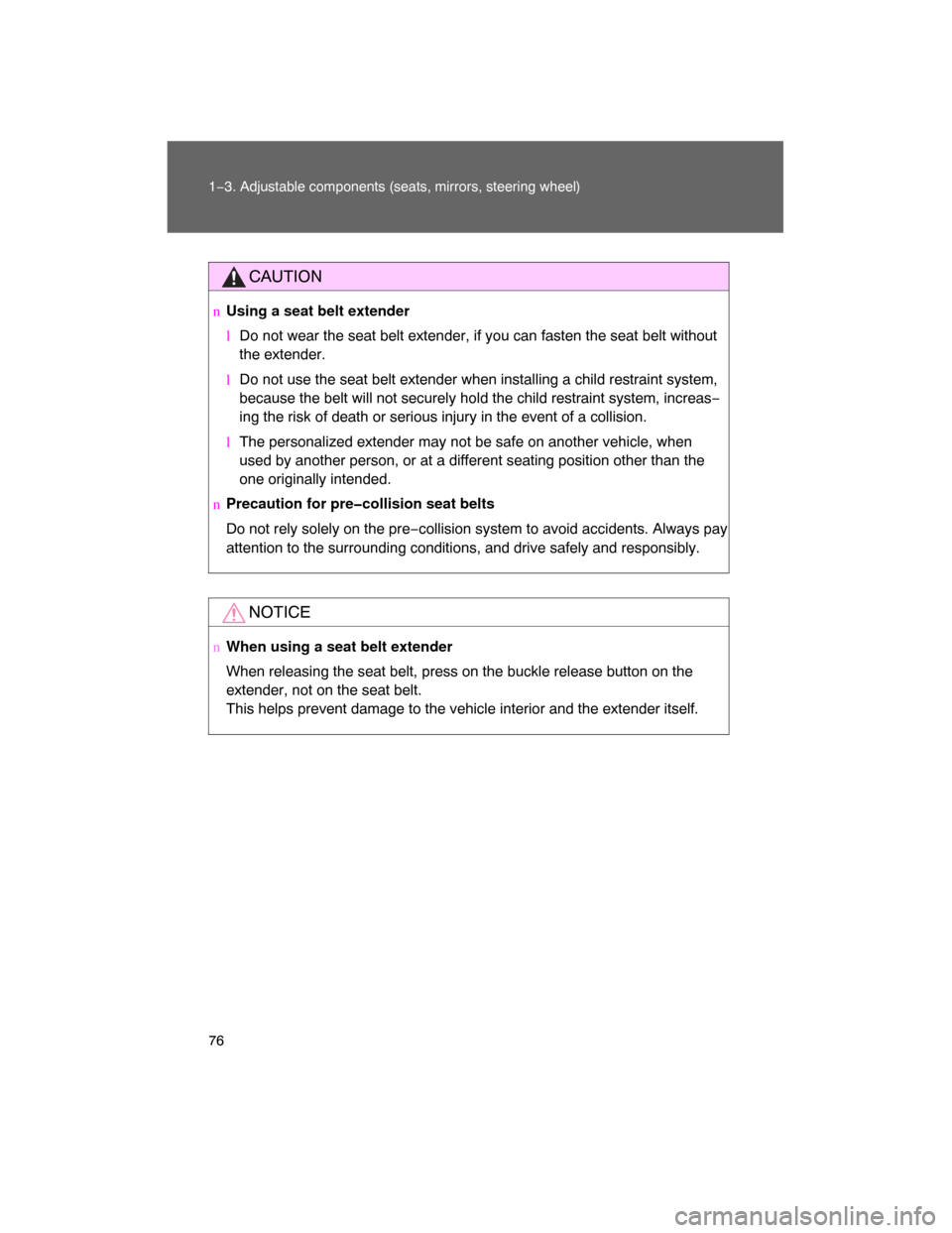Page 74 of 531

75
1−3. Adjustable components (seats, mirrors, steering wheel)
1
Before driving
CAUTION
nWhen using the third center seat belt
nSeat belt damage and wear
lDo not damage the seat belts by allowing the belt, plate or buckle to be
jammed in the door.
lInspect the seat belt system periodically. Check for cuts, fraying, and loose
parts. Do not use a damaged seat belt until it is replaced. Damaged seat
belts cannot protect an occupant from death or serious injury.
lEnsure that the belt and tab are locked and the belt is not twisted. If the
seat belt does not function correctly, immediately contact your Toyota
dealer.
lReplace the seat assembly, including the belts, if your vehicle has been
involved in a serious accident, even if there is no obvious damage.
l
Do not attempt to install, remove, modify, disassemble or dispose of a seat
belt. Have any necessary repairs carried out by your Toyota dealer. Inap−
propriate handling of the pretensioner may cause it to activate or operate
improperly and may cause death or serious injury.
Do not use the third center seat belt with
either buckle released. Fastening only
one of the buckles may result in death or
serious injury in case of sudden braking
or a collision.
Page 75 of 531

76 1−3. Adjustable components (seats, mirrors, steering wheel)
CAUTION
nUsing a seat belt extender
lDo not wear the seat belt extender, if you can fasten the seat belt without
the extender.
lDo not use the seat belt extender when installing a child restraint system,
because the belt will not securely hold the child restraint system, increas−
ing the risk of death or serious injury in the event of a collision.
lThe personalized extender may not be safe on another vehicle, when
used by another person, or at a different seating position other than the
one originally intended.
nPrecaution for pre�collision seat belts
Do not rely solely on the pre−collision system to avoid accidents. Always pay
attention to the surrounding conditions, and drive safely and responsibly.
NOTICE
nWhen using a seat belt extender
When releasing the seat belt, press on the buckle release button on the
extender, not on the seat belt.
This helps prevent damage to the vehicle interior and the extender itself.
Page 99 of 531
100
1−7. Safety information
Cor rect driving posture
Drive with a good posture as follows:
Sit upright and well back in
the seat. (
P. 5 1 )
Adjust the position of the
seat forward or backward to
ensure the pedals can be
reached and easily
depressed to the extent
required. ( P. 51)
Adjust the seatback so that
the controls are easily oper−
able.
Adjust the tilt and telescopic
positions of the steering
wheel downward so the air−
bag is facing your chest.
(P. 77)
Lock the head restraint in
place with the center of the
head restraint closest to the
top of your ears. ( P. 65)
Wear the seat belt correctly.
(
P. 69)
ITY17C002
Page 100 of 531

101
1−7. Safety information
1
Before driving
CAUTION
nWhile driving
lDo not adjust the position of the driver ’s seat.
Doing so could cause the driver to lose control of the vehicle.
lDo not place a cushion between the driver or passenger and the seatback.
A cushion may prevent correct posture from being achieved, and reduce
the effectiveness of the seat belt and head restraint, increasing the risk of
death or serious injury to the driver or passenger.
lDo not place anything under the front seats.
Objects placed under the front seats may become jammed in the seat
tracks and stop the seat from locking in place. This may lead to an acci−
dent. The adjustment mechanism may also be damaged.
nAdjusting the seat position
lDo not recline the seat more than necessary when the vehicle is in motion,
to reduce the risk of sliding under the lap belt.
If the seat is too reclined during an accident, the lap belt may slide past the
hips and apply restraint forces directly to the abdomen or your neck may
contact the shoulder belt, increasing the risk of death or serious injury.
lTake care when adjusting the seat position to ensure that other passen−
gers are not injured by the moving seat.
l
Do not put your hands under the seat or near the moving parts to avoid
injury.
Fingers or hands may become jammed in the seat mechanism.
Page 101 of 531
102
1−7. Safety information
SRS airbags
The SRS airbags inflate when the vehicle is subjected to certain
types of severe impacts that may cause significant injury to the
occupants. They work together with the seat belts to help reduce the
risk of death or serious injury.
Front airbags
Driver airbag/front passenger airbag
Can help protect the head and ches t of the driver and front pas−
senger from impact with interior components.
Knee airbags
Can help provide driver and front passenger protection.
Page 103 of 531
104 1−7. Safety information
Airbag system components
Front passenger airbag
Airbag sensor assembly
Front passenger occupant
classification indicator light
Occupant detection sensor
SRS warning light and
“RSCA OFF” indicator light
Driver airbag
Front passenger ’s seat belt
buckle switch
Driver ’s seat belt buckle
switch
Driver ’s seat position sensorFront airbag sensor
Curtain shield airbag
Side airbag (front seat)
Curtain shield airbag sensor
Side and curtain shield airbag
sensor
Knee airbag
Side airbag
(second outboard seat)
Roll sensing of curtain shield
airbags off switch
Floor sensor
1415111173
18151798210 10
61216131651213
14
ITY17C006
Page 105 of 531

106 1−7. Safety information
nOperating conditions (front airbags)
lThe SRS front airbags will deploy if the severity of the frontal impact is
above the designed threshold level, comparable to an approximate 15
mph (25 km/h) collision when the vehicle impacts straight into a fixed bar−
rier that does not move or deform.
However, this threshold velocity will be considerably higher if the vehicle
strikes an object, such as a parked vehicle or sign pole, which can move or
deform on impact, or if the vehicle is involved in an underride collision (e.g.
a collision in which the front of the vehicle “underrides”, or goes under, the
bed of a truck, etc.).
lIt is possible that in some collisions where the forward deceleration of the
vehicle is very close to the designed threshold level, the SRS front air−
bags and the seat belt pretensioners may not activate together.
lThe SRS front passenger airbag will not activate if there is not passenger
sitting in the front passenger seat. However, the front passenger airbag
may deploy if luggage is put in the seat or the seat belt is fastened, even
if the seat is unoccupied.
nOperating conditions (side airbags and curtain shield airbags)
lThe SRS side airbags and curtain shield airbags are designed to inflate
when the passenger compartment is subjected to a severe impact from
the side.
lThe SRS side airbag on the passenger seat will not activate if there is no
passenger sitting in the front passenger seat. However, the side airbag
on the passenger seat may deploy if luggage is put in the seat or the seat
belt is fastened, even if the seat is unoccupied.
Page 109 of 531

110 1−7. Safety information
CAUTION
nSRS airbag precautions
Observe the following precautions regarding the airbags.
Failure to do so may cause death or serious injury.
lThe driver and all passengers in the vehicle must wear their seat belts
properly.
The SRS airbags are supplemental devices to be used with the seat belts.
lThe SRS driver airbag deploys with considerable force, and can cause
death or serious injury especially if the driver is very close to the airbag.
The National Highway Traffic Safety
Administration (“NHTSA”) advises:
Since the risk zone for driver airbag is the first 2 − 3 in. (50 − 75 mm) of
inflation, placing yourself 10 in. (250 mm) from your driver airbag provides
you with a clear margin of safety. This distance is measured from the cen−
ter of the steering wheel to your breastbone. If you sit less than 10 in. (250
mm) away now, you can change your driving position in several ways:
�Move your seat to the rear as far as you can while still reaching the
pedals comfortably.
�Slightly recline the back of the seat.
Although vehicle designs vary, many drivers can achieve the 10 in.
(250 mm) distance, even with the driver seat all the way forward, sim−
ply by reclining the back of the seat somewhat. If reclining the back of
your seat makes it hard to see the road, raise yourself by using a firm,
non−slippery cushion, or raise the seat if your vehicle has that feature.
�If your steering wheel is adjustable, tilt it downward. This points the air−
bag toward your chest instead of your head and neck.
The seat should be adjusted as recommended by NHTSA above, while still
maintaining control of the foot pedals, steering wheel, and your view of the
instrument panel controls.